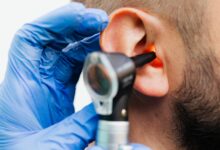
Gum pain can be a sign of inflammation (gingivitis), infection or a canker sore. It can become disabling, but can also be avoided. By following a serious oral hygiene.
Description
The gums are part of the oral mucosa and help hold the teeth firmly in place. They are part of the periodontium: the supporting tissue of the teeth, with bone and supporting fibers (called periodontium).
When the tooth is clean, the surrounding gum tissue is pinkish in color. But if the tooth is not properly cleaned, plaque builds up on its surface and the gumline can become sore.
While brushing the teeth, they may be sensitive and cause mild pain. But the pain can persist, be more or less strong, and more or less disabling (it may be for example that they prevent a correct diet).
Gum pain can be accompanied by other symptoms, such as:
- reddish, swollen, shiny gums;
- persistent bad breath ;
- bleeding while brushing your teeth or that persists;
- numbness or tingling;
- but also dental pain.
The causes
In most cases, gum pain is caused by inflammation of the gums, this is called gingivitis:
- plaque (invisible film loaded with bacteria that is deposited daily on the teeth) accumulates;
- it hardens (if not removed by toothbrushing) and becomes tartar;
- small infections are created;
- this can lead to inflammation of all the supporting tissues, this is called periodontitis.
Other causes of gum pain include:
- incorrect positioning of an orthodontic appliance or a dental prosthesis;
- the presence of a mouth ulcer or an abscess;
- or even an infection, a yeast infection .
Evolution and possible complications
If left untreated, gum pain can become a recurring pain, lead to abscesses, or even cause tooth loss. Gum pain can also prevent good nutrition.
Treatment and prevention: what solutions?
Gum pain can be prevented by taking care of your oral hygiene. It is therefore advisable to:
- brush your teeth and tongue twice a day (at least 20 to 30 minutes after eating);
- use fluoridated toothpaste;
- limit the consumption of sugary foods or drinks;
- favor a balanced diet;
- or do not smoke or chew tobacco.
Also, it is essential to consult a dentist regularly. It is all the more so if the gums change color, start to bleed, shine or swell, or if a taste of metal appears in the mouth.
To relieve gum pain and see it disappear, you have to treat what is causing it. For example:
- antibiotic or antiseptic treatment, scaling and monitoring of strict oral hygiene, in the event of gingivitis ;
- mouthwashes, in case of mouth ulcers;
- or the repositioning of the ill-fitting prosthesis or braces.










